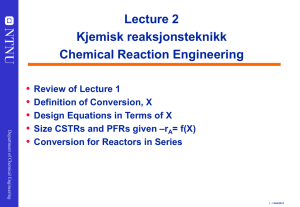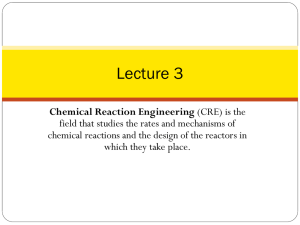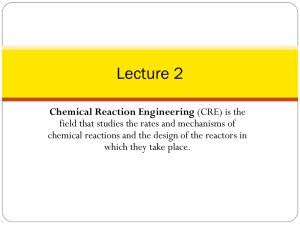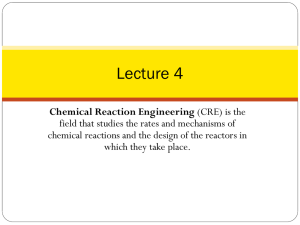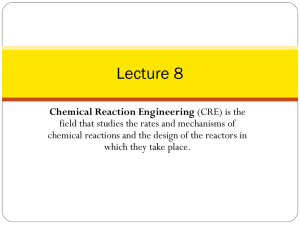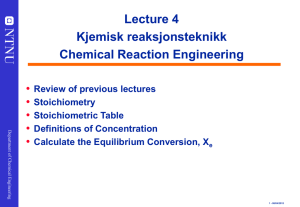Steady State Nonisothermal Reactor Design
advertisement
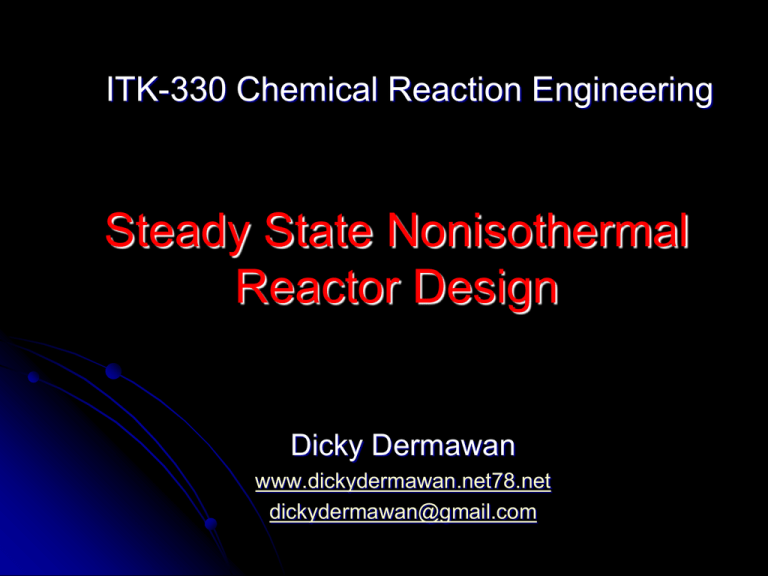
ITK-330 Chemical Reaction Engineering Steady State Nonisothermal Reactor Design Dicky Dermawan www.dickydermawan.net78.net dickydermawan@gmail.com Rationale All reactions always accompanied by heat effect: exothermic reactions vs. endothermic reactions Unless heat transfer system is carefully designed, reaction mass temperature tend to change Design of heat transfer system itself requires the understanding of this heat effect Energy balance is also needed, together with performance equations derived from mass balance Objectives Describe the algorithm for CSTRs, PFRs, and PBRs that are not operated isothermally. Size adiabatic and nonadiabatic CSTRs, PFRs, and PBRs. Use reactor staging to obtain high conversions for highly exothermic reversible reactions. Carry out an analysis to determine the Multiple Steady States (MSS) in a CSTR along with the ignition and extinction temperatures. Analyze multiple reactions carried out in CSTRs, PFRs, and PBRs which are not operated isothermally in order to determine the concentrations and temperature as a function of position (PFR/PBR) and operating variables Why Energy Balance? Imagine that we are designing a nonisothermal PFR for a first order liquid phase exothermic reaction: Performance equation: Kinetics: dX rA dV FA 0 rA k CA E k k1 exp a R 1 1 T1 T X X( V) T T(V) T T(X) FA 0 C A Stoichiometry: 0 Combine: The temperature will increase with conversion down the length of reactor C A C A0 (1 X) FA0 0 C A0 Ea dX k1 exp dV R 1 T 1 T1 1 X 0 X X ( T, V ) Energy Balance At steady state: n W F Q s i0 i 1 n n dEˆ sy s i 1 i 1 dt W F H F H Q s i0 i0 i i n H i0 Fi H i i 1 0 n In : Fi0 H i0 FA0 H A0 FB0 H B0 FC0 H C0 FD0 H D0 FI0 H I0 i 1 n Out Fi H i FA H A FB H B FC H C FD H D FI H I i 1 Consider generalized reaction: A ba B ac C da D FA FA 0 (1 X) FB FA 0 ( B ba X) FC FA 0 ( C ac X) Upon substitution: n Fi0 H i0 i 1 H H A B H B0 H B C H C0 H C Fi H i FA0 A0 D H D0 H D I H I0 H CI i 1 n - FA0 X n n i 1 i 1 Fi0 H i0 Fi H i n da H D ac H C ba H B H A FA0 i H i 0 H i i 1 FD FA 0 ( D da X) FI FA 0 I FA0 X HRx (T) Energy Balance (cont’) n n i 1 i 1 Fi0 H i0 Fi H i n FA 0 i Hi Hi 0 i 1 FA0 X HRx (T) From thermodynamics, we know that: T H i H i (TR ) C pi dT o TR Ti 0 H i0 H i (TR ) C pi dT o Thus: TR T T ~ Hi Hi0 Cpi dT Cpi (T Ti0 ) Ti 0 ~ C pi ˆ T T H Rx (T ) H oRx (TR ) C p R H oRx (TR ) da H oD (TR ) ac H oD (TR ) ba H oD (TR ) H oD (TR ) T ˆ C pi C pi dT TR T TR C p d a C pD c a C pC b a C pB C pA C pi dT Ti 0 T Ti0 Energy Balance (cont’) Upon substitution: n n i 1 i 1 n n n i 1 i 1 i 1 Fi0 H i0 Fi H i n FA 0 i Hi Hi 0 i 1 FA0 X HRx (T) ~ F H F H F C i0 i0 i i A0 i pi (T T0 ) FA 0 X [H oRx (TR ) Cˆ p T TR ] Finally…. n n i 1 i 1 W F H F H 0 Q s i0 i0 i i n ~ ˆ T T 0 Q Ws FA0 i C pi (T Ti0 ) FA0 X H oRx (TR ) C p R i 1 So what? Energy Balance (cont’) For adiabatic reactions: Q 0 0 When work is negligible: W s The energy balance at steady state becomes: n ~ ˆ T T 0 FA0 i Cpi (T Ti0 ) FA0 X H oRx (TR ) C p R i 1 After rearrangement: n X ~ C i pi (T Ti0 ) i 1 ˆ H oRx (TR ) C p T TR This is the X=X(T) we’ve been looking for! Application to Adiabatic CSTR Design Case A: Sizing: X specified, calculate V (and T) FA 0 X rA Performance equation: V Kinetics: rA Stoichiometry: CA CA0 (1 X) Combine: V k CA E k k1 exp a R 1 1 T1 T FA0 X k C A0 (1 X) Solve the energy balance for T Calculate k n X ~ i C pi (T Ti0 ) i 1 ˆ H oRx (TR ) C p Calculate V using combining equation T TR Application to Adiabatic CSTR Design Case B (Rating): V specified, calculate X (and T) FA 0 X rA Performance equation: V Kinetics: rA Stoichiometry: CA CA0 (1 X) Mole balance: V k CA E k k1 exp a R 1 1 T1 T FA0 X mb k CA0 (1 X mb) n Energy balance: X eb ~ C i pi (T Ti0 ) i 1 ˆ H oRx (TR ) C p T TR Find X & T that satisfy BOTH the material balance and energy balance, viz. plot Xmb vs T and Xeb vs T in the same graph: the intersection is the solution Application to Adiabatic CSTR Design Example: P8-5A The elementary irreversible organic liquid-phase reaction: A+BC is carried out adiabatically in a CSTR. An equal molar feed in A and B enters at 27oC, and the volumetric flow rate is 2 L/s. (a) (b) Calculate the CSTR volume necessary to achieve 85% conversion Calculate the conversion that can be achieved in one 500 L CSTR and in two 250 L CSTRs in series H oA (273K) 20 kcal/ mol C pA 15 cal/mol.K C A0 0.1 mol/L H oB (273K) 15 kcal/ mol C pB 15 cal/mol.K k 0.01 mLols at 300 K H oC (273K) 41kcal/ mol C pC 30 cal/mol.K E a 10000cal/mol Application to Adiabatic CSTR Design Case A: Sizing: X specified, calculate V (and T) FA 0 X rA Performance equation: V Kinetics: rA Stoichiometry: CA CA0 (1 X) k CA CB E k k1 exp a R 1 1 T1 T CB CA0 (B B X) CA0 (1 X) V Combine: FA0 X k CA02 (1 X) 2 0 X k CA0 (1 X) 2 ~ H oRx (273) H oC H 0A H oB 41 20 15 6 kcal/mol - 6000cal/mol i C pi C pA B C pB 15 15 30 cal/mol K n ˆ C C C 30 15 15 0 C p pC pA pB i 1 Energy balance: n X Calculate k ~ i C pi (T Ti0 ) i 1 ˆ H oRx (TR ) C p 0.85 30 (T 300) T 300 T 300 0.85 200 470K (6000) 200 T TR 10000 1 1 L k 0.01 exp 4.317 mol s 1.987 300 470 Calculate V using combining equation V 2 0.85 4.317 0.1 (1 0.85) 2 175 L Application to Adiabatic CSTR Design Case B (Rating): V specified, calculate X (and T) FA 0 X rA Performance equation: V Kinetics: Stoichiometry: Mole balance: rA k CA CB E k k1 exp a R CA CB CA0 (1 X) V 0 X mb k CA0 (1 X mb) 2 500 Energy balance: 1 n Xmb 0.8 Xeb X eb 0.6 0.4 1 1 T1 T 10000 1 1 0.01 exp 0.1 (1 X mb ) 2 1.987 300 T ~ i Cpi (T Ti0 ) i 1 ˆ H oRx (TR ) C p 2 X mb T TR X eb 30 (T 300) T 300 (6000) 200 0.2 0 300 350 400 450 500 T 300 310 320 330 340 350 360 370 380 390 400 410 420 430 440 450 460 470 480 482 484 485 490 500 Xmb 0.172 0.245 0.325 0.406 0.482 0.552 0.613 0.666 0.711 0.750 0.783 0.810 0.834 0.854 0.871 0.885 0.898 0.908 0.918 0.919 0.921 0.922 0.926 0.933 Xeb 0.000 0.050 0.100 0.150 0.200 0.250 0.300 0.350 0.400 0.450 0.500 0.550 0.600 0.650 0.700 0.750 0.800 0.850 0.900 0.910 0.920 0.925 0.950 1.000 Application to Adiabatic PFR/PBR Design Example for First Order Reaction dX rA dW FA 0 Performance equation: rA Kinetics: Stoichiometry: Gas Energy balance: n ~ i Cpi (T Ti0 ) H Combine: i 1 o Rx ˆ T T (TR ) C p R rA rA (X, P) 1 X P T0 1 X P0 T CA CA0 (1 X) liquid n n ~ ~ ˆ T X C ˆ T C X H oRx X C T i pi i Cpi T0 p p R i 1 i 1 n n ~ ~ ˆ T X H o X C ˆ T C C T X C i pi i pi T0 p Rx p R i 1 k k (T ) C CA (X, T, P) k (X) A CA CA (X, P) T T ( X) T T ( X) rA rA (k[X], CA [X, P]) CA CA0 CA 1 1 T1 T dP T P 0 (1 X) for PFR/small P: P/P0 = 1 dW 2 T0 P / P0 Pressure drop: X k Ea k k1 exp R i 1 T T(X) X H T o Rx n ~ ˆ X C p TR i C pi T0 i 1 n ~ i Cpi X Cˆ p i 1 dX f ( rA ) f ( X, P) Thus dW The combination results in 2 simultaneous dP g ( X, T, P ) g ( X, P ) differential equations dW P8-6A Sample Problem for Adiabatic PFR Design Sample Problem for Adiabatic PBR Design NINA = Diabatic Reactor Design Heat Transfer Rate to the Reactor n ~ W F C Q s A0 i pi (T Ti 0 ) FA 0 X H Rx 0 i 1 The rate of heat transfer from the exchanger to the reactor: n FW C~ (T T ) HXF oRx(T TTCˆ) 0 s A0 i p i i0 A0 R p R i1 U A Ta1 Ta 2 Q T Ta1 ln T Ta 2 Rate of energy transferred between the reactor and the coolant: Combining: NINA = Diabatic Reactor Design Heat Transfer Rate to the Reactor (cont’) At high coolant flow rates the exponential term will be small, so we can expand the exponential term as a Taylor Series, where the terms of second order or greater are neglected: n FW C~ (T ) HXF (T Cˆ) T 0 s A0 i pi i0 A0 Rx Ro p R i1 Then: The energy balance becomes: n ~ F C U A Ta1 T W s A0 i pi (T Ti 0 ) FA 0 X H Rx 0 i 1 P8-4B Sample Problem for Diabatic CSTR Design Sample Problem for Diabatic CSTR Design Application of Energy Balance to Diabatic Tubular Reactor Design U A T T Q a1 Heat transfer in CSTR: In PFR, T varies along the reactor: Thus: A V A Q U Ta T dA U Ta T dV V A luas selimut tabung reaktor dQ U a Ta T V volume tabung reaktor dV a For PBR: b W W 1 V dV dW V b b Thus: dQ Ua Ta T dW b D L D 2 4 L 4 D a Application of Energy Balance to Diabatic Tubular Reactor Design The steady state energy balance, neglecting work term: n ~ o ˆ T T 0 Q FA 0 Θ i C pi (T Ti0 ) FA 0 X ΔHRx (TR ) ΔC p R i1 T T o Q FA 0 Θ i C pi dT FA 0 X ΔHRx (TR ) ΔC p dT 0 To TR Differentiation with respect to the volume V: T dX dQ dT dT o FA 0 Θ i C pi FA 0 X ΔC p FA 0 ΔHRx (TR ) ΔC p dT 0 dV dV dV dV TR dQ dX Inserting U a Ta T and recalling that rA FA 0 dV dV dT rA [ΔHRx (T)] 0 U a Ta T FA 0 Θ i C pi X ΔC p dV Or: dT U a Ta T r A [ ΔHRx (T )] g( X, T ) dV FA 0 Θ i C pi X ΔC p Coupled with dX rA f ( X, T) dV FA 0 Form 2 differential with 2 dependent variables X & T Sample Problem for Diabatic Tubular Reactor Design Design for Reversible Reactions ΔG R T ln K d(ln K) ΔHRx dT R T2 Xeq = Xeq (K) = Xeq (T) Endotermik: K naik dengan kenaikan T Xeq naik reaksikan pada Tmax yang diperkenankan Eksotermik: K turun dengan kenaikan T Xeq turun reaksikan pada T rendah Laju reaksi lambat pada T rendah! Ada trade off antara aspek termodinamika dan kinetika Design for Reversible Highly-Exothermic Reactions -rA = -rA (X,T) Generally: At X = Xeq : Higher X slower reaction rate Higher T faster rate -rA = 0 Design for Equilibrium Highly-Exothermic Reactions #1 Starting with R-free solution, between 0 dan 100oC determine the equilibrium conversion of A for the elementary aqueous reaction: 0 A R ΔG 298 3375 cal/mol ΔH0298 18000 cal/mol The reported data is based on the following standard states of 0 CR C 0A 1mol/L reactants and products: Assume ideal solution, in which case: 0 CR / CR C K R KC CA C A / C 0A In addition, assume specific heats of all solutions are equal to that of water 0 Cp 1 cal/g. C Design for Equilibrium Highly-Exothermic Reactions: Reaction Rate in X – T Diagram 1 1 k( T) 0.0918 exp5859 T 298 X rA( X T) k( T) CA0 1 X K( T) Reaction Rate in The X – T Diagram at CA0 = 1 mol/L 1 0.9 0.8 r 0 01 A r 0.7 0 025 A r A Konversi 0.6 0 05 r A 0.5 0 1 r A 0.4 0 25 r A 0 5 0.3 r A 1 r 0.2 A 2 r A 0.1 0 0 10 20 30 40 50 Suhu, C 60 70 80 90 100 4 Design for Equilibrium Highly-Exothermic Reactions: Optimum Temperature Progression in Tubular Reactor #3 a. b. Calculate the space time needed for 80% conversion of a feed starting with initial concentration of A of 1 mol/L Plot the temperature and conversion profile along the length of the reactor Let the maximum operating allowable temperature be 95oC Design for Reversible Reactions: Heat Effect n U A ~ (T Ta ) Θ i C pi (T Ti0 ) F i1 X A0 ˆ T T ΔHo (T ) ΔC Rx R p R Design for Equilibrium Highly-Exothermic Reactions: CSTR Performance Design for Equilibrium Highly-Exothermic Reactions: CSTR Performance #4 A concentrated aqueous A-solution of the previous examples, CA0 = 4 mol/L, FA0 = 1000 mol/min, is to be 80% converted in a mixed reactor. a. If feed enters at 25oC, what size of reactor is needed? b. What is the optimum operating temperature for this purpose? c. What size of reactor is needed if feed enters at optimum temperature? d. What is the heat duty if feed enters at 25oC to keep the reactor operation at its the optimum temperature? Interstage Cooling Review on Energy Balance in CSTR Operation U A Ta T n ~ 0 F C F X H W ( T T ) s A0 i pi 0 A0 Rx 0 i 1 Bila term kerja diabaikan dan HRx konstan: FA0 X Untuk CSTR: V H 0Rx n UA ~ FA 0 i C pi (T T0 ) T Ta FA 0 i1 FA 0 X rA rA V H 0Rx UA FA0 Cp0 (T T0 ) T Ta FA0 Pembagian kedua ruas dengan FA0: UA rA V 0 T Ta H Rx Cp0 (T T0 ) Cp0 F C A0 p0 FA0 UA FA 0 C p0 Tc FA 0 C p0 T0 U A Ta U A FA 0 C p0 T0 F UCA Ta A0 UA F C p0 1 T0 Ta 1 Review on Energy Balance in CSTR Operation Tc rA V H 0Rx Cp0 [(T T0 ) T Ta ] FA0 V T0 Ta 1 Cp0 [T T (T0 Ta )] Cp0 [T ( 1) Tc ( 1)] FA 0 X rA Cp0 ( 1) (T Tc ) X H0Rx Cp0 ( 1) (T Tc ) G ( T ) R (T ) Bandingkan dengan n X ~ i Cpi (T T0 ) i 1 ˆ H oRx (TR ) C p T TR Multiple Steady State & Stability of CSTR Operation Multiple Steady State: Stability of CSTR Operation Finding Multiple Steady State: Varying To Temperature Ignition – Extinction Curve Upper steady state Lower steady state Ignition temperature Extinction temperature Runaway Reaction Sample Problem on Multiple Steady State in CSTR Operation P8-17B


